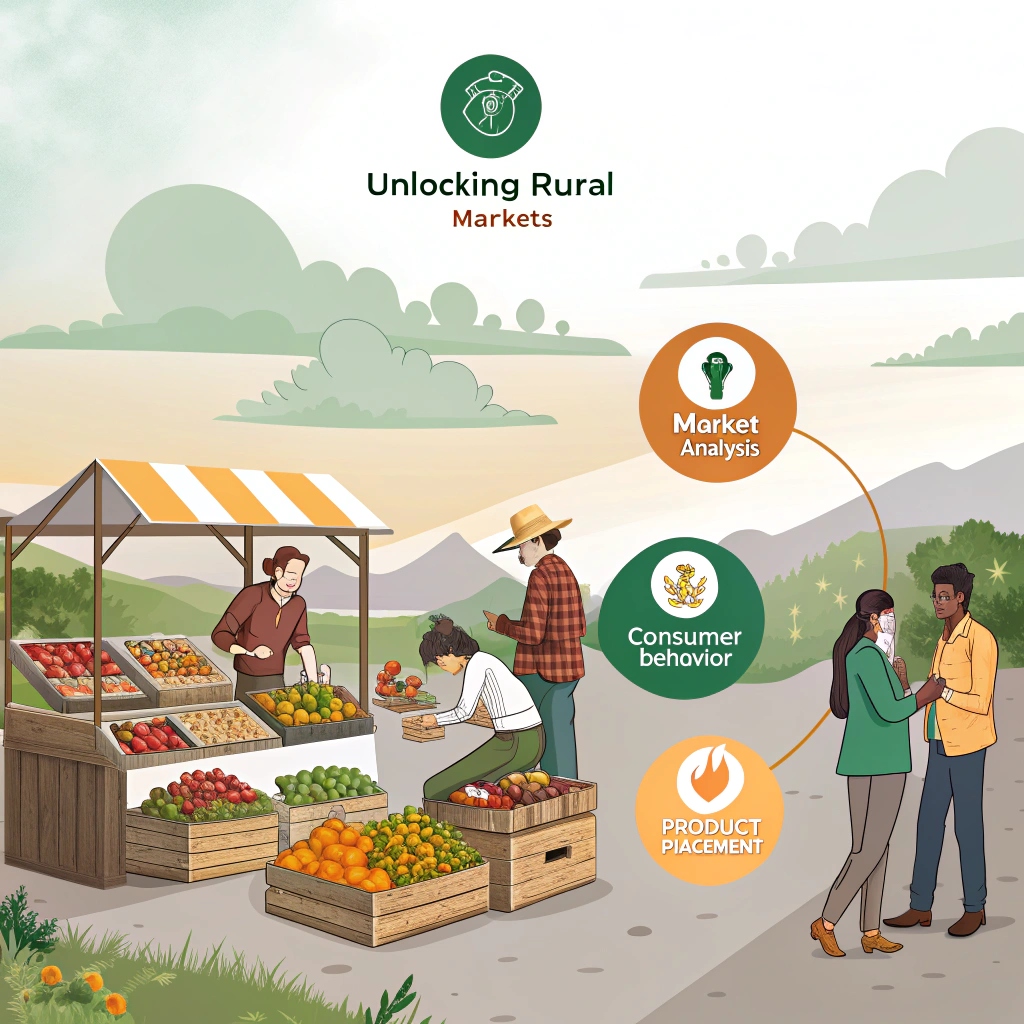
Introduction
Rural markets represent a significant untapped opportunity for businesses worldwide. With unique consumer behaviors, diverse demographics, and varying purchasing power, rural areas require tailored marketing strategies to effectively reach and engage with their populations. This blog explores the critical components of Segmentation, Targeting, and Positioning (STP) in the context of rural markets. By understanding these strategies, businesses can unlock the potential of rural consumers and drive sustainable growth.
Understanding STP Framework
Before diving into rural market specifics, let’s briefly review the core concepts of STP:
- Segmentation : Dividing the market into distinct groups based on shared characteristics such as demographics, psychographics, behavior, or geography.
- Targeting : Selecting specific segments that align with the company\’s goals, resources, and capabilities.
- Positioning : Crafting a unique value proposition that resonates with the chosen target audience, differentiating the brand from competitors.
These three steps work together to create a cohesive marketing strategy that maximizes relevance and effectiveness.
Why Focus on Rural Markets?
Rural markets are often overlooked due to perceived challenges like low purchasing power, limited infrastructure, and fragmented demand. However, they offer several advantages:

- Growing Population : Rural areas account for a significant portion of the global population, with many regions experiencing steady demographic growth.
- Changing Consumer Behavior : Rising disposable incomes, improved connectivity, and increased exposure to urban lifestyles are driving demand for modern products and services.
- Brand Loyalty : Rural consumers tend to be more loyal to brands that genuinely understand and cater to their needs.
- Competitive Advantage : Fewer competitors mean less saturation and higher potential for market penetration.
Despite these opportunities, rural markets present unique challenges that require strategic approaches. This is where smart segmentation, targeting, and positioning come into play.
Step 1: Segmentation in Rural Markets
Segmentation involves dividing the rural market into smaller, homogeneous groups based on relevant criteria. Here are key factors to consider:
Demographic Segmentation
- Age : Different age groups have varying needs. For example, young families may prioritize educational tools, while older consumers might focus on healthcare products.
- Income Level : Rural consumers have diverse income levels, ranging from subsistence farmers to small business owners. Tailoring products and pricing strategies is crucial.
- Education : Educational attainment influences product awareness and adoption. Higher education levels may lead to greater interest in technology and premium products.
Psychographic Segmentation
- Lifestyle : Rural consumers often have distinct lifestyles shaped by cultural norms, traditions, and daily activities. Understanding these nuances helps tailor messaging.
- Values and Beliefs : Religious beliefs, community values, and family-oriented mindsets play a significant role in purchase decisions.
- Aspirations : Many rural consumers aspire to improve their quality of life through better access to healthcare, education, and modern amenities.
Behavioral Segmentation
- Purchase Frequency : Some rural consumers may make infrequent but high-value purchases (e.g., agricultural equipment), while others buy frequently in smaller quantities.
- Usage Rate : Understanding how products are used helps design offerings that meet specific needs. For example, a farmer may use fertilizers differently than an urban gardener.
- Brand Loyalty : Identifying loyal customers can help build long-term relationships through loyalty programs and personalized offers.
Geographical Segmentation
- Accessibility : Proximity to towns, cities, or transportation hubs affects purchasing behavior. Remote areas may rely more on e-commerce or local vendors.
- Climatic Conditions : Seasonal variations and regional climates influence demand for certain products, such as clothing, food, or agricultural inputs.
Example: Segmenting Rural Farmers
Agricultural companies often segment rural farmers based on:
- Crop Type : Cereal growers vs. fruit and vegetable producers.
- Farm Size : Small-scale vs. large-scale operations.
- Technology Adoption : Early adopters of modern farming techniques vs. traditional methods.
By segmenting farmers this way, companies can develop targeted solutions, such as specialized fertilizers or digital tools for crop management.
Step 2: Targeting Rural Markets
Once segments are identified, the next step is to select the most promising ones to target. Effective targeting requires balancing market potential with resource constraints.
Criteria for Target Market Selection
- Size and Growth Potential : Focus on segments with sufficient scale and projected growth.
- Profitability : Assess the cost of serving each segment versus the expected return.
- Competition : Identify segments where competition is lower or where your brand has a competitive edge.
- Alignment with Company Goals : Ensure the target segment aligns with your overall business objectives.
Real-World Scenario: Amul in India
Amul, India’s largest dairy cooperative, successfully targets rural consumers by:
- Understanding Needs : Recognizing that rural households prioritize affordable and nutritious dairy products.
- Local Partnerships : Collaborating with local cooperatives to ensure fresh milk supply and distribution.
- Affordable Pricing : Offering products at competitive prices to match rural consumers’ budgets.
- Community Engagement : Running campaigns that resonate with rural values, such as “The Taste of India.”
This approach has helped Amul become a trusted brand in both rural and urban markets.
Step 3: Positioning in Rural Markets
Positioning involves defining how your brand will be perceived by the target audience. In rural markets, effective positioning requires authenticity, simplicity, and relevance.
Key Considerations for Positioning
- Unique Value Proposition (UVP) : Clearly communicate what sets your product or service apart.
- Relevance : Ensure your brand message addresses the specific needs and aspirations of rural consumers.
- Trust and Credibility : Build trust through transparent communication and reliable delivery.
- Simplicity : Use straightforward messaging that is easy to understand, especially in multilingual or culturally diverse regions.
Case Study: Samsung’s Rural Strategy
Samsung has successfully positioned its products in rural India by:

- Affordable Tech : Launching budget-friendly smartphones and appliances tailored to rural consumers’ needs.
- Local Marketing : Using local languages and culturally relevant advertising to connect with audiences.
- Service Infrastructure : Setting up service centers in remote areas to address post-sales concerns.
- Community Initiatives : Supporting rural education and livelihood programs to enhance brand perception.
Through these efforts, Samsung has established itself as a trusted provider of technology in rural markets.
Tools and Techniques for STP in Rural Markets
To implement STP effectively, businesses can leverage various tools and technologies:
- Data Analytics : Use data from surveys, sales records, and social media to gain insights into rural consumer behavior.
- Focus Groups : Conduct interviews and group discussions with rural consumers to gather qualitative feedback.
- Online Platforms : Leverage e-commerce platforms and social media to reach rural audiences and gather real-time data.
- Mobile Technology : Utilize mobile apps and SMS campaigns to engage with consumers who may not have internet access.
Flowchart: STP Process in Rural Markets

Overcoming Challenges in Rural Markets
While STP provides a robust framework, rural markets present unique challenges that must be addressed:

- Infrastructure Limitations : Poor roads, limited internet connectivity, and inadequate logistics can hinder distribution.
- Seasonality : Agricultural cycles and weather patterns affect consumer spending habits.
- Cultural Sensitivity : Failing to respect local customs and traditions can alienate consumers.
- Limited Awareness : Educating rural consumers about new products or services requires sustained effort.
Solution: Hybrid Approach
Combining online and offline strategies can overcome these challenges. For example:
- E-commerce Platforms : Reach consumers through mobile-based e-commerce sites like Flipkart or Amazon.
- Physical Distribution : Partner with local retailers or set up kiosks in rural areas for product availability.
- Awareness Campaigns : Use local influencers, radio, and community events to spread brand awareness.
Conclusion
Unlocking the potential of rural markets requires a thoughtful application of the STP framework. By carefully segmenting rural consumers, selecting the right target segments, and crafting compelling positioning strategies, businesses can build strong connections with these underserved populations.
Key Takeaways:
- Segmentation : Divide rural markets into meaningful groups based on demographics, psychographics, behavior, and geography.
- Targeting : Choose segments that align with your business goals and resources.
- Positioning : Develop a unique value proposition that resonates with rural consumers and builds trust.
With the right approach, rural markets can become a significant driver of growth for businesses across industries. As rural areas continue to evolve, staying agile and adaptive will be key to success.
Call to Action
Are you looking to expand your business into rural markets? Contact us today to learn how our team of experts can help you develop a tailored STP strategy. Together, we can unlock the full potential of rural consumers and drive sustainable growth for your brand.








